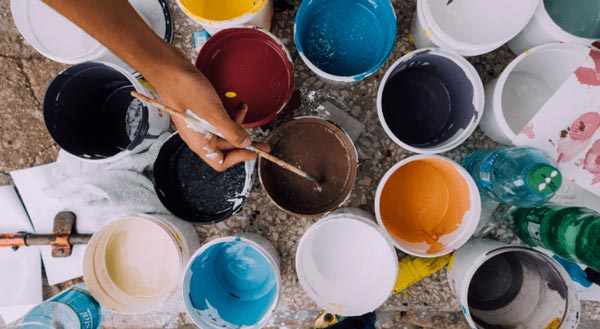Table of Contents
There are several helpful types of art therapy projects for addiction recovery. Art therapy allows people to try something new and explore different forms of personal expression. For some people, painting is a great art therapy project because of how affordable and accessible the painting medium can be.
In this article, we’re looking at the benefit of art therapy and several art therapy projects for addiction recovery.
Art Therapy Projects for Addiction Recovery
As our culture evolves past the stigma formerly associated with the struggle of addiction, our treatment options for assisting people along the road to recovery have expanded. The focus on treatment has become more holistic, meaning that the entirety of a person’s well-being is taken into consideration. The journey to a life of sobriety starts with the ceasing of substance use, but sustaining it requires that the formerly addicted person achieve a sense of wellness and purpose in life.
Throughout the ages, art has been used to tap into our deepest emotional and spiritual experiences. The emotions conveyed through art mediums such as painting, sculpting, theater, and music simply cannot be manifested through simple speech and common language. The power of artistic expression in communicating the journey to, through, and out of addiction has been recognized by innovative substance abuse treatment centers and is being utilized as another tool in the vast toolbox of recovery.
Here are some benefits of exploring art therapy projects for addiction recovery.
No Artistic Talent Needed
The primary focus of art therapy for addiction treatment is not the artist’s skill level. No artistic skill is needed to enjoy the benefits. The benefit of art therapy lies in creating an expression that transcends words. Whether your experiences lead you to create a mural or a three-word poem, the healing process stems from the fact that you are creating something of your own. Creating something from your soul means that there will be nothing else in the world that looks or sounds the same. Your art will be as unique as you are and will reflect your perspectives and experiences.
Related: How Does Art Therapy Work?
Benefits of Art Therapy
Art therapy studies have shown that it reduces all manner of symptomology, resulting in relief from physical, mental, and emotional pain. For those experiencing substance abuse and addiction from a co-occurring position, relief from these symptoms may be the key to shedding the desire to escape through substance use. For some, treating psychological and physical pain is the key to recovery.
Art therapy also provides a unique opportunity to form social bonds. There has been a multitude of studies that show that connection to others within our community is vital to our mental and emotional well-being. The vulnerable state that many people experience when starting with art creation provides fertile ground for developing social ties that might otherwise be stunted by the presence of personal defense mechanisms and mistrust.
The primary benefit of art therapy lies in its power to foster self-discovery. Art has a way of revealing the thoughts and feelings that tend to lie deep within our unconscious mind, similarly to the way that dreams operate. It provides a healthy outlet for releasing these inner experiences, and releasing them into the tangible world can result in a clean inner slate for creating your road map for the journey of recovery. Art therapy participants are also likely to experience an increased sense of self-esteem as they realize the existence of their inner artist. An increase in self-esteem fuels people to keep going when the road to recovery starts looking too long.
Art Therapy Approaches
The availability of art therapy approaches will vary according to the treatment center. Artistic projects can range from being invited to draw one picture to full-fledged involvement in an art therapy treatment program. Therapists specially trained in art therapy undergo an extensive educational program where they learn the various modes of artistic expression and their accompanying psychological significance. This level of available expertise isn’t required to receive the benefits of creating a work of art, however, as those who have minimal training can successfully lead a recovery group in an exercise toward producing a work of self-expression.
Types of Art Therapy
There are several types of art therapy available today. It doesn’t matter which type of art therapy you try so long as you’re trying something new.
Drama Therapy
Drama therapy uses the role of an actor to facilitate the process of separating ourselves from the obscuring viewpoint of being too close to our situation. It encourages participants to view life from various roles, try new behaviors, and develop communication skills. The intimate setting of sharing the acting experience with others in a group also works to solidify social bonds between those in recovery.
Painting and Drawing
Chances are, if you have ever visited an art gallery, you have encountered a painting or two that looks like your toddler could have produced it. Rather than viewing that as an insult, that is one of the beautiful aspects of art. Art creations depend on the artist being able to tap into something inside and get that feeling or impression out on paper. Painting and drawing are very popular forms of art therapy, as there is no wrong way to put feelings onto a canvas.
Collages
Collages are a form of art therapy that can be accomplished by even the most artistically timid. Rather than creating a work of inner expression from scratch, participants are instructed to locate visual and tactile objects already existing in the world and compile them into space that communicates meaning to the individual. The options for what this collage space can mean for the creator are endless.
Sources:
- Flannigan C. Improving Your Everyday Life Through Art Therapy Paint, Sculpt, or Color Your Way to Relaxation. Hey Sigmund. Published June 15, 2017. Accessed October 10, 2022. https://www.heysigmund.com/art-therapy/
- Klammer S. Collage Therapy: Integrating the Gift of Loneliness. GoodTherapy.org Therapy Blog. Published July 17, 2013. Accessed October 10, 2022. https://www.goodtherapy.org/blog/collage-therapy-integrating-gift-of-loneliness-0717137
The Heights Treatment Editorial Guidelines
There is a vast amount of misinformation online especially as it relates to health & wellness. We have made it our mission at The Heights Treatment to provide accurate, medically sound content that has been medically reviewed by a doctorate level clinician so that you can trust the information contained within our website.


